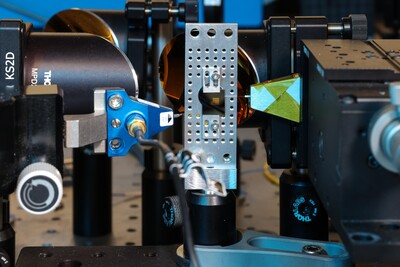Hybrid photonic-terahertz chip enhances communications

Researchers at EPFL and Harvard University have engineered a chip that can convert between electromagnetic pulses in the terahertz and optical ranges on the same device. Their integrated design could enable the development of devices for ultrafast telecommunications, ranging, spectroscopy and computing.
Terahertz radiation describes a band of waves on the electromagnetic spectrum with frequencies higher than microwaves (which are used in telecommunications technologies like Wi-Fi) but lower than infrared light (used in lasers and fibre optics). Their short wavelengths mean that terahertz (THz) signals can transmit large amounts of data very fast, but connecting THz radiation to existing optical and microwave technologies has been extremely challenging.
In 2023, researchers in the Laboratory of Hybrid Photonics came one step closer to bridging this gap when they created an extremely thin photonic chip made of lithium niobate that, when connected to a laser beam, produced finely tailorable THz waves. Now, the team has reported a novel design that not only generates THz waves but detects incoming ones as well by converting them to optical signals.
This bi-directional conversion on a single, miniaturised platform is an essential step towards bridging the THz and optical domains, and could enable the development of compact and power-efficient devices for communication, sensing, spectroscopy and computing. The research has been published in Nature Communications.
“In addition to demonstrating the first detection of THz pulses on a lithium niobate photonic circuit chip, we generated THz electric fields over 100 times stronger and increased the bandwidth by a factor of five (going from 680 GHz to 3.5 THz),” said Cristina Benea-Chelmus, head of the Laboratory of Hybrid Photonics.
From terahertz radar to 6G communications
PhD student and first author Yazan Lampert explains that the team’s innovative design centres on embedding micron-sized structures called transmission lines into their lithium niobate photonic chip. These lines act like chip-scale radio cables to guide THz waves along the chip. By placing a second structure nearby to guide optical (light) waves, the scientists enhanced interaction and conversion between the two with minimal energy loss.
“We can control both optical and THz pulses on the same platform simply through our miniaturised circuit design. Our approach combines photonic circuits and THz circuits on a single device with unprecedented bandwidth,” Lampert said.
The broadband THz signals generated by the hybrid device could for example be used to develop terahertz-based radar, in which extremely short THz pulses could be used to estimate an object’s distance (ranging) within one millimetre. Thanks to its compact and energy-efficient design, the chip is also compatible with existing photonic technologies like lasers, light modulators and detectors. The team is already working on fully miniaturising the chip design to enable seamless integration into the next generation of communications and ranging systems, such as those used in self-driving cars.
Amirhassan Shams-Ansari, the co-first author of this work and currently a Principal Laser Engineer at DRS Daylight Solutions (formerly a postdoctoral researcher at Harvard University), said: “Thin-film lithium niobate has proven to be a powerful platform for integrated photonics, enabling a new generation of applications and devices. It is truly exciting to see this technology advancing into the highly promising yet underexplored THz domain.”
“We anticipate that the design guidelines we propose will become crucial in future terahertz applications such as high-speed 6G communications, where sensing and ranging will be an essential component of the communication network,” Benea-Chelmus said.
Preventing radiation-induced faults in electronics
Researchers are developing an open-source tool to enhance the prevention of radiation-induced...
QUT to establish photochemical mass spectrometer
A new mass spectrometry facility will be established in Queensland to enable real-time...
Enhancing computer cooling with ionic technology
Researchers have developed a new cooling technique for computer chips, using nanoscale channels...






